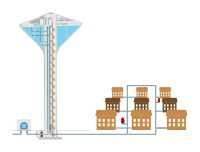
Photo from wikipedia
Pressure regulation is the most common strategy for leakage reduction in water distribution networks (WDNs). The literature also offers many studies pointing to the benefits of coupling pressure regulation with… Click to show full abstract
Pressure regulation is the most common strategy for leakage reduction in water distribution networks (WDNs). The literature also offers many studies pointing to the benefits of coupling pressure regulation with energy production in WDNs. To this end, a turbine can recover the energy that is otherwise dissipated by the Pressure Reducing Valve (PRV). However, although numerical simulations developed for various sites show high potential revenues and attractive capital payback periods, to date there are very few field installations. The main difficulty is that flow and pressure vary continuously at the network inlet, thus requiring real time control (RTC) of the valves and turbine to ensure adequate service levels. A recent paper discusses the operation of a laboratory prototype, which is able to both maximize energy production and regulate pressure in a WDN, with an optimization algorithm identifying the optimal operation of valves and turbine, commanded in real time according to the network operation. Because the earlier paper mainly discusses the theoretical framework of the optimization problem supported only with preliminary experiments, the present paper presents extensive laboratory experiments and analysis demonstrating the prototype’s ability to both regulate pressure at the critical node of the WDN and maximize power generation, in any operating condition. The results were also compared with theoretical values, showing very good agreement in all cases.
Journal Title: Water Resources Management
Year Published: 2018
Link to full text (if available)
Share on Social Media: Sign Up to like & get
recommendations!